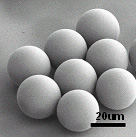Information about The Thin Film & Charged Particle Research Laboratory.
 The Thin Film & Charged Particle Research Laboratory, also known as the Kim Lab, investigates multi-modality contrast agents based on nanoparticles for targeted cancer imaging and treatment and generation of uniform micro- and nano-spheres and microcapsules of precisely controlled size, shell thickness, charge, and porosity for biomedical and other applications. We research charged liquid cluster beam generation and application to the fabrication of highly structured thin films, nanoparticles, nanofibers, and in-situ pattern generation. We are interested in studying the growth of group-III nitride semiconductors and fabrication of power electronic devices using plasma-assisted MBE. We are developing novel techniques for thin film deposition and fabrication of nanotubes, nanofibers and nanowires using plasmas, charged particles, electrostatic spraying, CVD and their combinations as well as novel flat panel displays including FED and OLED.
The Thin Film & Charged Particle Research Laboratory, also known as the Kim Lab, investigates multi-modality contrast agents based on nanoparticles for targeted cancer imaging and treatment and generation of uniform micro- and nano-spheres and microcapsules of precisely controlled size, shell thickness, charge, and porosity for biomedical and other applications. We research charged liquid cluster beam generation and application to the fabrication of highly structured thin films, nanoparticles, nanofibers, and in-situ pattern generation. We are interested in studying the growth of group-III nitride semiconductors and fabrication of power electronic devices using plasma-assisted MBE. We are developing novel techniques for thin film deposition and fabrication of nanotubes, nanofibers and nanowires using plasmas, charged particles, electrostatic spraying, CVD and their combinations as well as novel flat panel displays including FED and OLED.
Our research interests consist of:
- Development of High Power Electronic Devices Based on III-V Nitride Semiconductors Using Plasma Assisted Molecular Beam Epitaxy
- Tissue Engineered Scaffolds with Embedded Microspheres to Improve Bone and Soft Tissue Healing Through Controlled Delivery of Growth Factors
- Precision Particle Fabrication: The Targeted Delivery of Microsphere Encapsulated Aminobisphosphonates for Treating Autoimmune and Neoplastic Diseases of The Mononuclear Phagocytic System
- Nanowire & Nanotube Interconnect Technology for 3D ICs
- Investigation of Novel Approaches to Fabricating Micro and Nanoscale Structures for Development of New Devices for Lighting, Display, and Power Storage
- Syntheses and Study of Tailored Organometallic, Inorganic and Polymeric Precursors for Sol-Gel Processing, Charged Liquid Cluster Beam Deposition and Chemical Vapor Deposition
- Investigation of Methods for Controlled Fabrication of Thin Films and Nanoparticles Using Charged Liquid Cluster Beams of Precursor Solutions
- Design of Microparticles for Precision Drug Delivery
- Development of Methods for Fabricating Uniform Micro and Nano Spheres and Capsules of Biodegradable and Biocompatible Materials for Application to Biotechnology
- Development of Novel Field Emission Display based on Copper Nanowires
Our Principal Investigator is Kyekyoon Kim.
If you would like to learn more, please check out our website here.
Project 1
Our goals consist of:
- Growth and fabrication of GaN-based Power Device using Molecular Beam Epitaxy
- Growth and characterization of AlN using unbalanced magnetron sputtering
- Fabrication of hybrid LC device on Si substrate

Project 2
Our goals include:
- Advanced Drug Delivery Mediated by Uniform Microsperes of Biodegradable Polymers
- Microcapsules for Drug Delivery and for Encapsulation of Cells

Project 3
Project 3 consists of:
- Copper Nanowires grown by Chemical Vapor Deposition: Structure and Growth Mechanism
- Fabrication of Field Emission Display Device using Copper Nanowires

Project 4
Our objects consist of:
- Theoretical study of the multi-jet flow-limited field-injected electrostatic spray (FFESS) technology.
- Fabrication, characterization, and application of copper nanoparticle, nanowire and thin film produced by FFESS-CVD technology.
- Field emission study of copper nanowires.
- Large-area coating and pattern generation on conducting and insulating substrate using FFESS technology.
Project 5
Our project includes:
- Deposition of Anatase Titania using Flow-Limited Field-Injection Electrostatic Spraying (FFESS)
- Copper Nanowires, Nanoparticles, and Thin Films by FFESS
- Direct-Writing of Silver Lines using Single-Jet Flow-Limited Field-Injection Electrostatic Spraying